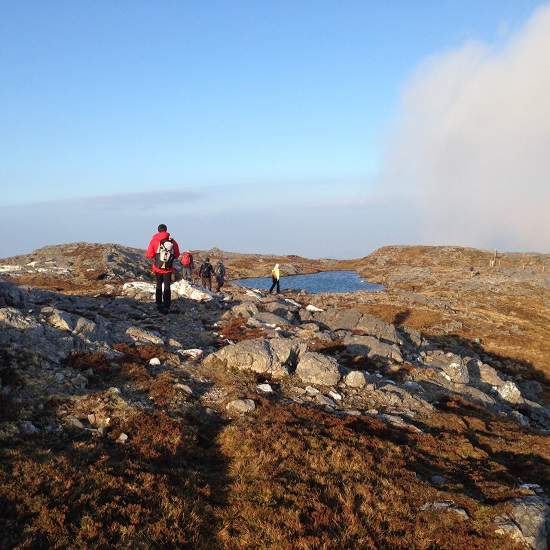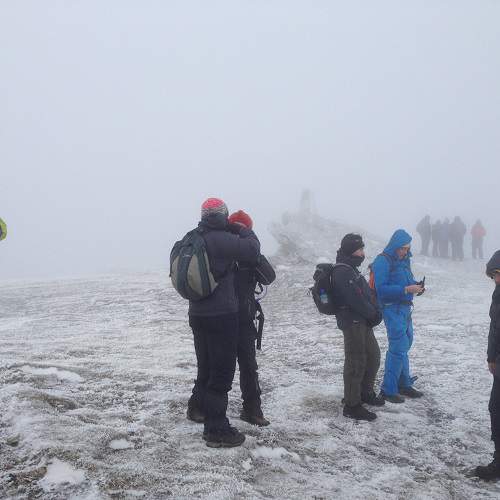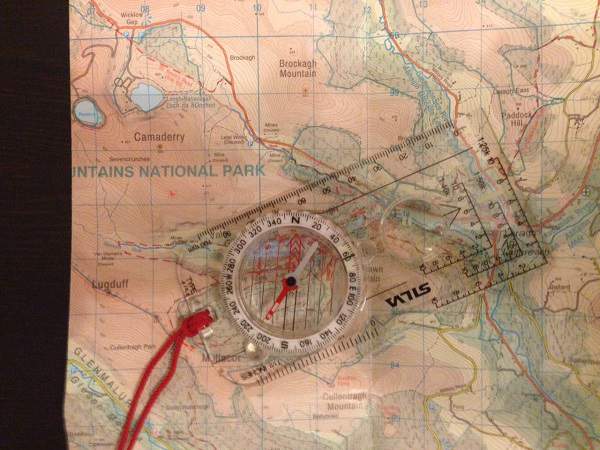When you go out hiking you’re going out into terrain in the wilderness. With that in mind, there are certain steps you can take to ensure you have as enjoyable an experience as possible.

While whole books can be, and are, written about hiking in safety, I thought a quick summary post with ten of, what I think, are the main tips you can easily implement to help keep you safe on your adventures out on the trail would be useful.
Every point below is applicable and so I am loathe to put these in any particular order of importance. In short, you need to tend to all of them on any hike you are preparing to undertake.
#1 Wear the Right Gear
This first one is probably one of the ones that is most often neglected. In this day and age, good gear is easily available and while it can be very expensive, there are plenty of reasonable options at reasonable prices available too.
Every other week when I go out hiking, I’m half way up a mountain and I see someone in Nike Air sneakers and jeans. Not advisable in any way. Although trail shoes can be grand on occasion as a general rule I recommend you have proper hiking boots.
As well as that, some kind of breathable warm clothing is advised so base layers (where required) hiking pants, tee’s, etc. should allow you to sweat but let excessive heat out and away from your skin to prevent moisture build up.
You also need to have layers for warmth so a fleece is a good option.
Finally, you need waterproof outer rain gear, so a rain jacket and rain pants. By this I mean stuff you slip on over your pants and top to protect you from heavy rain.
#2 Carry Additional Layers
As with wearing the right hiking gear, you need to carry any extra that you need. So if it isn’t raining, you should have your waterproofs packed away in your pack. You should also have an extra layer or two for warmth and protection in case it is needed.

I didn’t mention this above, as you don’t really wear it, although you do kind of I guess, but you need to have a good day pack with you, to carry these additional layers and your other bits and pieces in while you’re out on the trail.
#3 Leave your Hiking Route with Someone
A simple yet excellent idea! Before you head out on your hike tell one or two people the following information:
- Where you’re going
- What time you are leaving
- When you expect to be back
Ideally, leave them a print out map of the area where you plan to go hiking with the route marked out on it. That way, if you don’t show up as scheduled, they know where to look for you. Also, be sure to leave it with people who will notice you are gone.
Just knowing where to look is a critical piece of information for any search and rescue teams should you have gotten into difficulty.
#4 Take Adequate Food and Water with you
You need to bring supplies of food and water with you, and it’s always good to bring a little extra just in case something should go wrong. There are of course plenty of options depending on what you like to eat, drink, etc.
For some idea on what I like to do, check out the posts the 10 best day hike foods and how much water should I take on a hike, where I cover what I like to do for my hikes.
#5 Take a Mobile Phone
A mobile phone is a critical piece of safety gear. It’s worth noting that even out of coverage for your network, it should still connect to an emergency number via any available network, as long as it can find one, should you need to.
If you’re hiking in a new area or a country that’s new to you, it’s worth checking before you go out on a hike that you know how to contact help and familiarizing yourself with safety protocols if someone in your party should get hurt.
#6 Have a Map and Compass
At the very least you should have a map of your hike and have an idea how to follow it. Ideally you should be versed with using a compass to take bearings etc. but in reality, that won’t be the case for many.

Take the time to look at your route on your map and pick out landmarks you expect to come across on your way and roughly how long you expect to get to them. That way, if you’re expecting to walk beside a large river in an hours time and you don’t see one, you know you’re off track.
Generally speaking though, if you’re new to hiking, stick to well marked trails which are clearly marked on your map that have easy escape routes back to safety.
#7 Hike with a Group
While I do love to hike solo, I do also enjoy hiking with a group too. The main advantage of hiking with a group in terms of safety? Well, if something happens to one of you, there are enough people to stay with the injured party while others go off to get help should they need to.
Be sure that everyone in the group is of similar fitness so they stay together. If some people are much fitter, a gap will form and people can lose each other, especially in foggy and misty conditions. Not good!
#8 Stay Within your Limits
There are a few points in this with regards to staying safe. Firstly, with regards to fitness, don’t take on something that’s too big a challenge for you. Only you will know your own fitness levels and if you get too far into something very demanding for you, you may not have the strength to walk back out.
As with anywhere, the trail can be a place where macho-ness can come to the fore, especially among men. In short, it’s just daft. If you’re not able for something, better to be honest about it than get yourself into a pickle and have to call for help. Not having the common sense to speak up and stand down from something too challenging for you, is very not macho 🙂 AKA stupid.
The other area of limits are the types of terrain and it’s state when you enter it. For example, if you’re not familiar with hiking in very snowy or boggy conditions, you would be wise to wait to go into that environment with someone who is. You will learn loads in a short space of time and probably save yourself a lot of hassle.
#9 Avoid Hazards
Hazards on the trail, fall into two main categories 1. natural and 2. man made. A natural hazard would be something like a steep cliff. A man made hazard would be an area used for forestry or by the military for shooting practice and man oeuvres.
Again, it’s back to your map and route planning. Most hazards should be highlighted on a good map and so you can plan your route accordingly.
However, many times you may come across a hazard as you hike which you weren’t expecting e.g. a swelled river after heavy rains. Where that occurs, you need to be wise and take appropriate evasive action to avoid the hazard.
#10 Have Emergency Kit with you
Ideally, someone in your party should have a first aid kit and someone else should have an emergency blanket and a bothy bag. Should someone take a nasty fall and get a bit of a gash on their leg, it is much better if you can treat it on the spot with a first aid kit which will have the basics in there i.e. some antiseptic wipes, plasters and tape.
Should someone have a more serious accident, it could be many hours before help can get to them so keeping them warm and protecting them from the elements will be paramount so an emergency blanket and bothy bag are a must to keep them protected until help arrives.
Conclusion
Safety on the hills and on the trail is a big thing for all hikers. If you follow these ten safety tips, you should be well on your way to fully enjoying your hike as much as possible, and also be prepared to act appropriately should a problem arise for you or any member of your hiking party.
I hope you found these hiking in safety tips useful for your adventures on the trail! As always, please leave any thoughts in the comments below.
Hi Colm! Thanks for sharing this great information. What shoes would you recommend to wear to people like me that are not into hiking and are just planning to go a day out for hiking with some friends. I’ve been checking out prices of the gear but for example the hiking boots are not pricey and I don’t want to make that purchase for a single occasional hiking. Thanks for your advise!
Hi Andrea, thanks for that, glad you found it useful.
I think the first thing is always to assess what terrain you’re going to be hiking in. As you’re not a regular hiker and it’s a one off, my guess is that the hike will be on open well marked trails so you won’t be going off trail into open mountain or wilderness. With that in mind, I think a pair of hiking shoes would be a good option for you. Hiking shoes are generally cheaper than their hiking boot counterparts and on top of that, you can easily use them for day-to-day use, they look great with a pair of jeans 🙂
One very popular option is the Merrell Moab Ventilator hiking shoes. I had a pair of these myself at one point and they were great for day-to-day use as well as trail walking. At about $90, they shouldn’t break the bank either and you will get a pretty good life out of them.
Hope that helps 🙂
Now, those are nice shoes to have around and also go hiking! Thank you so much. Yes, you’re right about the terrain; It should be something easy and chilled… friends’ fun! I will also check some other models! Thank you again, Colm!
You’re very welcome Andrea, glad you like them 🙂
They should give you a good idea of what to look for with regards to functional purposes. You’re right though, there are lot’s of hiking shoe options available so it is worth taking a look around to see what ones catch your eye.
I believe that mobiles will allow emergency calls if a network can be found even if its not your own. If there are no networks then you don’t have the ability to send a message even if its an emergency.
Hi Mark, thanks for that.
I did a bit of research too and found the same information, if there is an available network, you can connect through. No network though and it seems you’re pretty much snookered.
Wonder is there a way to check for networks before you set off. Then if none available it is more imperative that you leave word with people of your route and what time you are expected back. So they can send out the search party if there is a no show.
Hmmnn, that’s an interesting one alright Mark. I’d always leave word of my route with people who will notice if I don’t return either way, but it would be good to know if your phone would be of any use or not before setting out. I must look into that a bit further too, be good to know.
It’s funny as I was on a hiking weekend trip a couple of weeks back and as we all sat at the dinner table after the hike, it seemed some of us had reception and some of us didn’t, (we were in Connemara so I guess out in the sticks a bit). That’s fine, some people will and some won’t as they’re on different networks. However, three of the guys were on the same network but one had no reception, another had two bars and the other had full reception! Was very odd. We put it down to the phones being faulty but Lord knows!
Hello Colm
As you say, all of these ten is important in no particular order. Another often forgotten thing is to train and prepare (with the backpack) in advance before you go on a longer hike. If you do you have the opportunity to break in your new hiking boots as well. If you want your feet full of blisters, hike in a pair of new boots. A thing I learned the hard way 😉
Hi Anders,
Yes indeed, that’s a really good point, training is important to get yourself used to being able to take on longer hikes and get used to carrying a pack full of gear, too much too soon is never a good thing. Nothing ever beats good preparation.
That’s a really good point about breaking in your hiking boots too. Nothing worse than hiking in bad boots or boots you haven’t broken in. I will add a note to this post I think to link to another post on breaking boots in, it’s something that can easily be forgotten. Sorry to hear you learned the hard way with that … at least it’s something you will never forget 🙂
Hi Colm,
Great post here for hikers. i am now past that age butstill go for walks in many places whenever possible just to remain as fit and active as possible. We found your 10 hiking tips spot on. Great information and well laid out. Taking a mobile phone is especially vital provided it is fully charged and can pick up a strong signal, something not always the case in some places.
Keep up the good work and may your site get lots of visitors as the go to place for hikers.
Stephen & Jennifer.
Hi Guys,
Thanks for stopping by and I’m really glad you enjoyed the post. I think even if you don’t have a signal, your mobile phone will still connect in an emergency. Doru mentioned that as well so I must check to confirm.
Thanks also for your kind wishes on the site, Much appreciated.
Colm.
Hi!
I love hiking, but I always leave in an expedition without my phone, because I thought that if I don’t have signal, wath’s the point. Thanks for sharing this and I wish you safe trips 🙂
Doru.
Hi Doru,
I think a phone is a really useful device to have while out on the trail. To the best of my knowledge, even if you have no signal, if you dial an emergency number it will be routed through the nearest satellite. That is, an emergency is prioritized through any available communications network. I think that in most cases you should be able to get through to help in an emergency, even without a signal. I could be wrong though, I will check it out to confirm.
Thanks for stopping by and I wish you safe trips too 🙂
Colm.